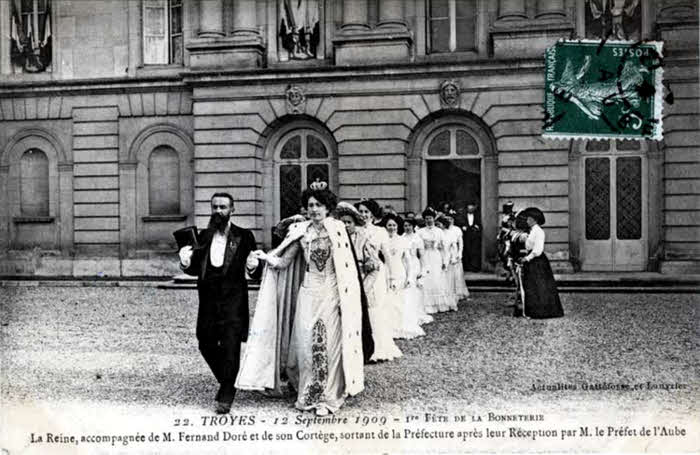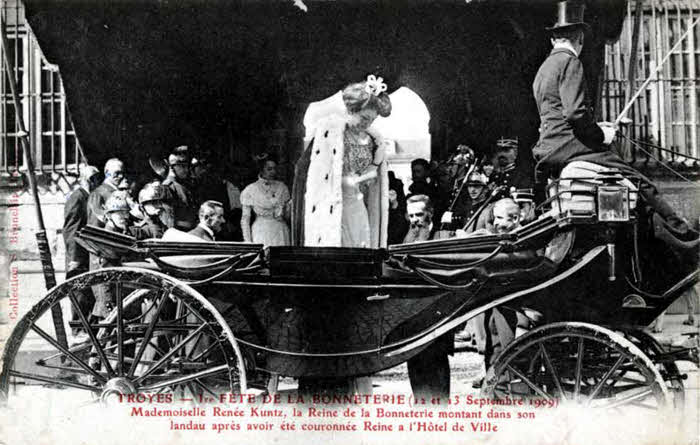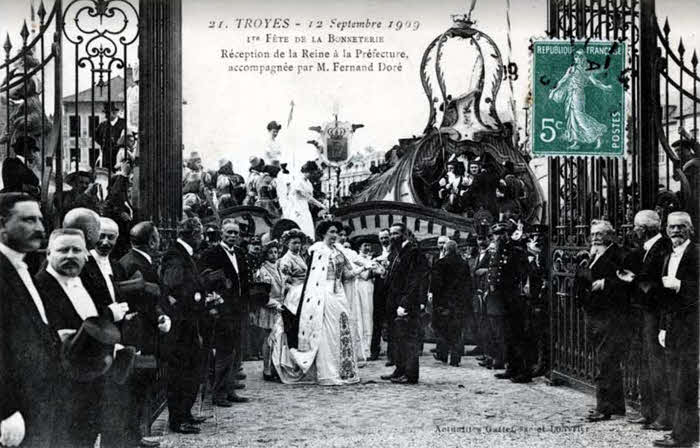By Plinio Corrêa de Oliveira
Scenes from the “belle epoque”. In the background of the first, a building both harmonious and grave. A long cortege of graciously-dressed ladies use from it. And, in the front, wearing a crown and dressed in an ermine mantle, a lady unites personal beauty with an elegance, richness and restraint of apparel. She gives her right hand to a person with grave mien who is conscious of the importance of his role, vested in the rigorous dress of gala: jacket, top hat, medals.
 What does it deal with? A scene of pomp from the small and brilliant courts so numerous in 1909, the date of the photograph?
What does it deal with? A scene of pomp from the small and brilliant courts so numerous in 1909, the date of the photograph?
The center of the next photograph is dominated by the same lady who has just entered an elegant carriage and is preparing to seat herself for departure. A coachman in livery and top hat serves her. An air of importance and seriousness is perceived in the countenances of the onlookers, who are obviously political and military officials. Once again, the photograph does not furnish sufficiently defined elements to judge whether it deals with an aspect of court life.
Finally, a third picture. Near the aristocratic latticework whose gates are open in welcome, we notice the same lady in the center, the same gentleman, to whom she gave her hand in the other photograph, some military men, and various people formally dressed in top hats and jackets. Well in the background is a pole decorated by a shield on which one reads the letter B, and topped by a crown. On a closer plane is a carriage of extremely imaginative lines with an equally bizarre arch also topped by a crown. And once again we ask the reader our question ⸺ is this a court scene?
 Everything indicates that the answer is yes ⸺ though a small, somewhat imaginative court (as seen in the peculiar lines of the carriage) and a somewhat rustic one (as one notes something unauthentic and artificial about the personages in full dress who have much of the “petit bourgeois.”) The lady is striking and unrestrained. But it would be difficult to say that she is authentically aristocratic. Hints and details can be perceived by a shrewd observer but that pass completely unnoticed by the majority.
Everything indicates that the answer is yes ⸺ though a small, somewhat imaginative court (as seen in the peculiar lines of the carriage) and a somewhat rustic one (as one notes something unauthentic and artificial about the personages in full dress who have much of the “petit bourgeois.”) The lady is striking and unrestrained. But it would be difficult to say that she is authentically aristocratic. Hints and details can be perceived by a shrewd observer but that pass completely unnoticed by the majority.
* * *
Then what do these pictures deal with? All this seriousness, this solemnity, and this protocol is to celebrate the “queen” for the Hoisery festival in Troyes. This city, the old capital of Champagne with its fifty or sixty thousand inhabitants, had in the beginning of the century only a very secondary importance. It tried to provide incentives for the local industries of which the Hoisery Festival was one of the most popular. The coronation of this “queen” served as an opportunity for brilliant festivities, appropriate to catch the attention of the press and tourists, and thus advertised their product. Hence the collaboration of the authorities. The second picture represents the moment when the “queen” is leaving the municipal court of Troyes after being crowned; the third photograph shows her arrival at the department of Aube at the Mayor’s Palace; and the first photograph is of her departure after the ceremony of the mayor’s visit.
 What is the purpose of our discourse? So that we better understand or feel how much the world is losing its seriousness in the course of this foolish and tormented century. Thus, in 1909, “queen” was presented as a “beauty” with her “poses” destined for great publicity. Today…the number of such “queens” has grown immensely, but the “poses” more appreciated by the multitudes are such that we dare not even make a comparison?
What is the purpose of our discourse? So that we better understand or feel how much the world is losing its seriousness in the course of this foolish and tormented century. Thus, in 1909, “queen” was presented as a “beauty” with her “poses” destined for great publicity. Today…the number of such “queens” has grown immensely, but the “poses” more appreciated by the multitudes are such that we dare not even make a comparison?
But the theme also lends itself to another observation. When a custom is dangerous, no matter how “conventional” or “innocent” it might seem at first, in reality all its dynamism tends to gradually abandon the correct forms and the distinctive decorations in order to show its sensual and vulgar essence. Thus, these “queens” who originated ⸺ for propaganda and the dry good business. And those men in full dress ⸺ those modest and noteworthy petty ⸺ bourgeois of Troyes in 1909 ⸺ what would they say if they could see the way that the “descendants” of successors of the “queens” of their time are generally presented today?
Taken from Ambiences, Customs & Civilizations. Published in “Catolicismo” Nº 65 – May 1956.









